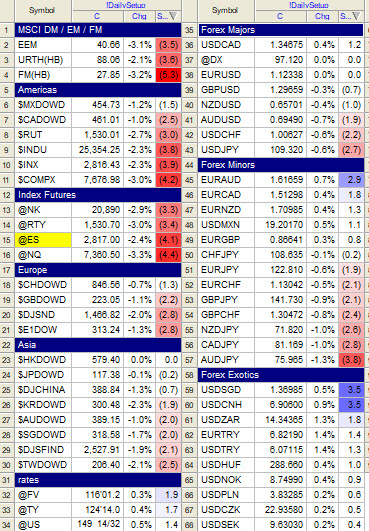Here’s a bit of a stream of consciousness post in response to today’s (5/13) market movements.

First, these types of moves are often called ‘risk off’ moves because we see nearly one-sided trading in different assets—people rush to sell assets that are perceived as risky (stocks are the standard example, with smaller cap and emerging market stocks usually rating higher on the risk scale); they rush to buy assets that are considered “safer”. Fixed income instruments and gold are the classic examples here.
There are other examples and many nuances to these “buckets of risk”, but the concept is valid. Let me share a few thoughts about these environments, and what usually comes next:
- There’s almost always a catalyst, but the reaction takes on a life of its own. Typically, we see feedback loops where selling leads to more selling (mechanically, just imagine stops being hit and that selling driving the market down furthers), and the resulting move is often far out of proportion to the catalyst. That’s because the move was not about the catalyst—it is about psychology.
- There’s usually a “perfect storm” alignment of other variables, ranging from economic, macro, geopolitical, to previous market moves. A corollary to this is that these moves usually don’t come out of nowhere. They can, but it’s more common to see them follow earlier signs of market stress.
- Technical patterns often don’t work as expected… these moves are largely unforecastable, though, again, they usually come from periods of stress. If you’re honest about it, you will see that most of these events sort of break whatever patterns or analytical structure you were using, or at least push it to extremes.
- Volatility increases, often dramatically.
- Markets overshoot all reasonable limits. Whatever levels define normal and extreme, expect markets will move to “next level extreme” or even beyond. Someone, after the fact, will show you an exact level that worked, but you won’t find it in real time.
- Correlations increase. In extreme situations, such as we haven’t seen for 10 years, nearly everything moves together in the short term. You might scratch your head and say “why are they selling bonds, cocoa futures, and tech stocks at the same time?” There’s no good answer, but it happens.
- These are rarely one-time events. There are aftershocks, but here’s the good news: a disciplined technical process will usually handle these aftershocks pretty well. They tend to be more predictable, and more tradable, than the event itself.
- There are two broad ways these things play out: the usual is for a quick recovery and everything is forgotten—whether in a week or a few months—and to see the technical damage absorbed easily. Though that’s the normal expectation, there are cases where these events lead to a cascade of sustained selling, and that’s what we call a bear market.
- You will likely be emotional. This environment is driven by human emotion, and anyone actively participating will at least feel some emotional contamination.
- Your job in these environments is to follow your plan and to try to not make mistakes.
Since the beginning of 2018, we’ve had a handful of these types of events. There will be more in the future, and we will eventually enter an environment where this type of stress lasts for months on end. Even though these are extreme and abnormal conditions, they are still part of the normal market cycle.
These thoughts will likely be more relevant soon, and the stress we’ve felt today will be more commonplace. Monitoring yourself—both your emotional state and your actions—because it’s so important I’ll repeat that: monitoring both what you feel and what you do, becomes very important.
If you find yourself struggling, then there’s a simple solution: get smaller. Reduce your trading size. Exit some trades. Focus on only taking the best possible trades as new trades. All of these are ways to reduce your size and your exposure.
Get smaller. As your positions get smaller, so do your problems. Managing both becomes a lot easier.